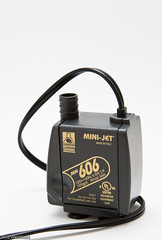Face-to-Face with Catfish
March 31st, 2008In my 54G corner aquarium, I’ve got quite a few different kinds of catfish. All of them are different looking, and each has a unique character.
The Ancistrus sp. L279 bristle-nose plecos stay around 3-4″, and are usually found sucking on the driftwood in the tank. They’re fairly timid, but do come out often enough to enjoy.
The Siamese Algae Eater, SAE, is a very common algae eating fish. They are commonly confused is the Flying Fox, which is not nearly as effective an algae eater. Becoming popular once they were observed eating black brush algae, they are often recommended to new aquarists as a means of algae control. Unfortunately, most people do not initially realize that the small fish they purchase in the store, turn into 6-7″ blimps. Despite their size, they’re usually lazy enough, lounging around most of the time in their old age, that they do not disturb the aquascape.
The Botia sidthimunki loach is a fantastic little catfish that stays small, is constantly active, and is very social when kept in a group. I have five of these in the tank, and they’re always scurrying around, chasing each other throughout the aquarium. They do not harass other tank mates, however, well, except for snails or shrimp!
I have a couple varieties of corydoras in this tank. Cories are also very social catfish, constantly searching the bottom areas of the tank. Occasionally, you will see one shoot from the substrate all the way up to the water surface, and then dart back down. Apparently, cories have adapted to be able to breath air from the surface, allowing them to survive in poorly oxygenated water. I’ve also witnessed them playfully swimming upside-down at the water surface for awhile before swimming back down to the bottom.
Overall, I can highly recommend all of these catfish, for different reasons. The A. sp. L279 are great little plecos that eat algae, but don’t overwealm the tank. The SAEs get bigger, but are peaceful, and also eat algae. The “sid the monkey” loaches are a great, active, addition to any tank, and will eliminate snails from your aquarium. And corydoras are just plain fun to watch!
























